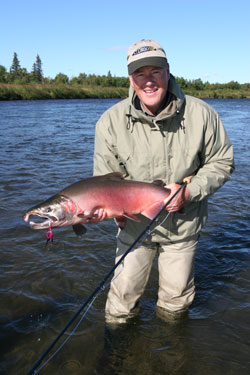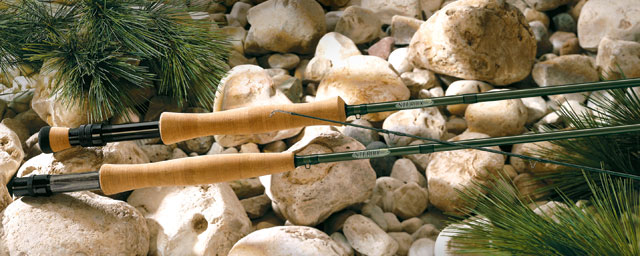Reasons for Change: The Thinking Behind “New and Improved”
As consumers, we’re fed (some would say force-fed) new product formulas on a regular basis. This applies to every product out there, from cars to food to soda-pop to, yes, fly rods. When manufacturers revise a rod line, I often wonder what went on during initial discussions, when a company officer probably announced that a product needed revising. Revised how? For that matter, why revise a solidly performing product at all?
St. Croix Rod is a company that has taken the lead and providing what’s currently overshadowed in the rod market: slower action rods. A while back, I interviewed Jason Brunner, their director of engineering, and Jeff Schluter, VP sales & marketing. We discussed marketing and technical concerns, and they outlined the thinking and design steps that go into creating a new, revised St. Croix product.
The discussion was centered around new Avid fly rods vs. older model Avids.
Morselli: So, the big question: why revise a popular rod model? I fish both generations of these rods, and my general observation is that that new Avids are trout rods, period—not so with the older models.

St. Croix VP Jeff Schluter with an Alagnak Salmon
Jeff: I believe you have the [older] AFT864 and the newer A864.4. They’re both 8’6”, 4-weight, 4-piece rods. A partial answer is that giving a product a cosmetic facelift usually keeps the brand fresh and relevant, resulting in continued or even improved sales.
The older gray Avids are in general a little bit faster in action compared to the new version. The new design is a more progressive action and a lot more consistent from line weight to line weight compared to the old. Our design process is much more mathematical now than in the past.
In addition, the Legend Elite [St. Croix’s top-tier fly rod] mandrels were used in production, but guide spacing has remained the same as previous generation Avids.
Jason: We wanted to use the same IPC tooling [i.e. mandrels] as the Legend Ultra series and knew it would result in slower actions because of the fiber modulus differences. We already had two fast-action fly series, the Legend Ultra and Legend Elite, but didn’t have a premium, USA-built moderate-action series. We decided the Avid should hit this niche. Granted, it’s a small niche, but there are highly skilled anglers who prefer a more moderate-action fly rod because of its ability to protect light tippets. They also excel in smaller streams and short-to-moderate casting distances. Today, the Avid Series is 100% focused on the trout market. The rod line includes many lighter line and shorter length models.
Jeff: St. Croix always changes cosmetics when a series is redesigned. You almost have to, otherwise the redesign doesn’t get fully recognized. We felt the series should be represented by a blank color that spoke to fly anglers. Earth tone greens are always popular in the fly market. Pearl and metallic pigments have become popular as well. Everyone has their opinion on cosmetics, and we felt like the canteen green pearl would be well received and it has.
The old Avids were very popular, but the life cycle was coming to an end. We know we could design a series that had better consistency (line weight to line weight). As an owner, I listen to our customers and what’s happening in the market. We like to communicate with the end user at sport shows, over the phone by email, etc. The green Avid was a complete redesign, not a facelift. Cosmetics are very personal. I know there are customers who loved the faster action gray, just as there are ones who love the green and the slower action the new Avid possesses. Also, keep in mind we came out with the fast-action Imperial shortly after the redesign of the Avid. Imperials have been our best-selling fly series since they were launched. That $200 price point is very strong right now and the Imperial hits it head on.
In general, fast-action fly rods are more popular than slow or moderate action offerings.

Rod updates are often as much about cosmetics as they are about performance, but the new Avid Series combines a little bit of both.
Jason: Since the last generation of Avids, we’ve also improved our manufacturing process. Such things include blank profiling, laser micrometers, laser alignment and a new dynamic analyzer which allows us to test strength more accurately than before. With these developments we’re able to review existing designs and brainstorm ways to make them better. The biggest thing thing we found with the old Avids was inconsistency. From model to model and weight to weight we found minor discrepancies that we can now clean up. We’ve developed a new profiling system that allows us to look at the action and power of each blank to classify actions and powers more accurately. Also, with the use of 3-dimensional solidworks prints, we developed better shop floor data, which is used in conjunction with our new quality control processes to make more consistent parts. All in all, we brought the blanks designs up to par with our recent factory developments.
Also, with all of our current engineering technologies on hand we have reduced our prototyping stage. All of our blanks are modeled on the computer to the point where we can see exactly what’s going on in a blank. This allows us to speed up the design process by catching flaws before we even build a part. Several of the new models were only prototyped two times—one to work out processing bugs and another to field test. A few models were prototyped three times for minor blank tweaking after field testing.
Several of the blanks were re-tooled to bring our IPC technology into play. The overall outer dimensions remained fairly consistent with the previous models, but we did improve on the wall thickness of several models. Here again, our computer designs allowed us to take a closer look, which enabled us to remove unnecessary material or clean up potential weak spots by adding material in certain areas. In some cases the new models became lighter from a blank standpoint, and all of them certainly became stronger and more consistent.











